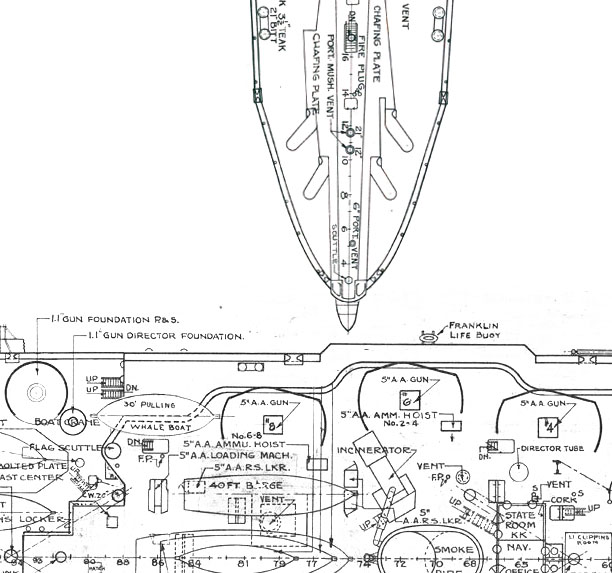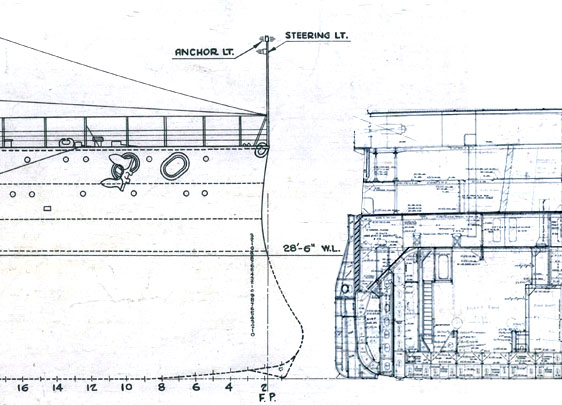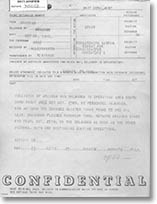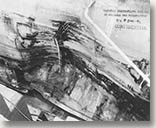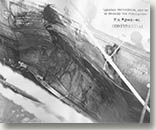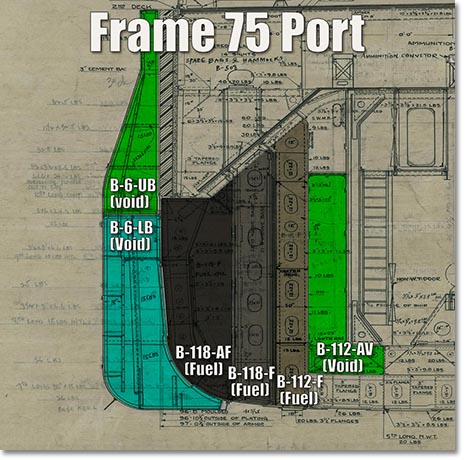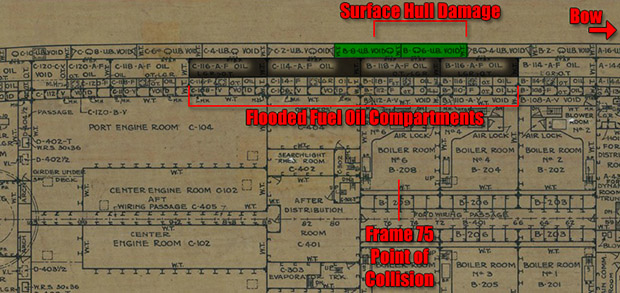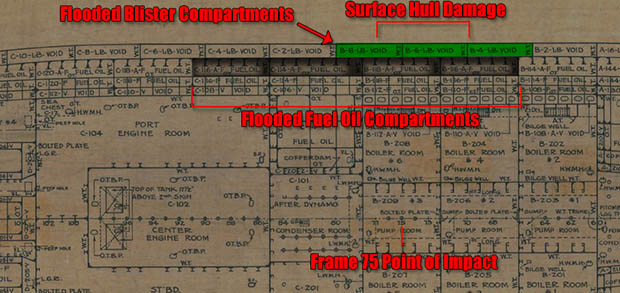
| TEXT SIZE: small | normal | large | huge |
On October 22nd, 1941 Battleship Arizona was hit by Battleship Oklahoma during exercises in the Pacific Ocean. The two ships (along with Nevada) were operating as Battleship Division One of the US Navy's Battle Fleet. There were no injuries and damage was comparitively slight for the armored battlewagons; however the incident put both ships in drydock for a short period of time. Below is information gleaned from various records at the US National Archives in College Park, Maryland, that may help the reader gain a better understanding of the event.
|
USS Arizona BB-39 Deck log excerpt, October 22 1941 1643 Changed course to 263ºT. 1702 Sighted OKLAHOMA bearing 233ºT., distance 2000 yards. 1702 Changed speed to 12 knots. 1703 Ceased fog signals 1705 Sighted NEVADA bearing 238ºT., distance 2000 yards. 1715 NEVADA and OKLAHOMA formed column astern. 1730 Changed course to 180ºT. 1734 Darkened Ship. 1735 Set contition three, second section. 1742 NEVADA and OKLAHOMA sheered out of column on signal from Commander Task Group 2.1 to take stations for scheduled exercise. 1800 Changed course to 120ºT. Changed speed and standard speed to 10 knots, forming cruising disposition 8-L, fleet axis 270ºT., fleet course 120ºT., fleet speed 10 knots, fleet guide ARIZONA. 1802 NEVADA and OKLAHOMA on port quarter. 1813 Turned on reference light as fleet guide. 1815 The following named man received the following injury: CASE, C.A. Bkr2c, diagnosis, wound, lacerated right leg, negligence not apparent, injury received while going out of hatch from casemate #4 to port side of gallery deck, man slipped and fell striking shin, causing lacerated wound about 1¼ inches long. 1816 Turned off reference light. 1817 Observed OKLAHOMA to port on a converging course. OKLAHOMA turned on running lights, ARIZONA turned on running lights, Captain took the conn, rudder was put over hard right, assumed flank speed, sounded one short blaset on whistle, sounded siren, collision quarters. OKLAHOMA sounded siren, NEVADA turned on running lights. NORTHAMPTON turned on running lights. Visibility with running lights on about 5000 yards. 1819 Collision occured port side frame 75, rudder was put over hard left. Stopped port engine. 1820 Stopped all engines. 1821 Turned on searchlight. 1822 Came right to 120ºT. 1824 Hoisted dip rope, preliminary examination showed evidence of damage to blisters B-4, B-6, and B-8 and oil tanks B-116 and B-118-AF. 1828 Ship listing 2.5º to port. 1843 All engines ahead one-third (3½ knots). 1845 Secured dip rope. 1846 Steadied on course 120ºT. 1850 Secured from collision quarters. 1853 Changed speed to two-thirds For those who are unfamiliar with the term "dip rope," the 1943 Bluejackets' Manual states, "A dip rope would be about 6 fathoms of 3-inch wire or an equivalent open-link chain, with a shackle large enough to engage a link of the anchor chain, and a 30-fathom length of 7-inch Manila. This line is led out through one hawse pipe, around the bow and in the other, and shackled to the end of the anchor chain to be dipped. It is used to haul this anchor chain around the bow and into the other hawse pipe." Special thanks to Jim Azelton for locating and sharing that page of Arizona's log. |
|
Using the Booklet of General plans for both Arizona and Oklahoma, we can show the comparative size and layouts of the two ships in the areas of the collision:
Documentation The Navy memo the two photos above were attched to stated, "damage below the waterline on the port side near frame 76, involving the following compartments:" Voids, outer compartments: Fuel tanks, inboard of the voids: Using this and plans we have available, we can build a graphic representation of the collision. But first. we should spend some time describing Arizona's structure so the reader has a better understanding of what they are examining. Before the US entry into the First World War, the US Navy had standardized a structure known as a "torpedo defense system" that consisted of separate compartments filled with air ("voids") and liquid (fuel oil). Much like a crush zone in a modern car, this system of compartments would absorb the concussive explosion of a torpedo and prevent much of the damage from reaching inside the important machinery sections of this ship while requiring less weight that an extension of the thick armor belt above. Pulling up what is known as a "transverse section" drawing that is set at Frame 75, the center of the damage, we see the following, with color added to make the separate compartments more understandable: The memo states that both upper and lower blisters at this frame were punctured and B-118-AF damaged and open to the sea as well. Overhead views of the decks show how forward and aft the sea water extended: The above plan is the "First Platform," which was a few feet under the waterline and is essentially where the inclined ladder drawn in the transverse section drawing above topped out at. Seawater only penetrated two compartments in from the outer shell of the ship, but it is interesting to note that it extended forward one blister compartment below this (See the "Hold" Deck plan below) and TWO fuel compartments aft. C-114-AF is perhaps not surprising given it's close proximity to the damage and forces exerted on the structures there, but the aft compartment C-116-AF presumably was fouled due to valve settings or some other issue not related to puncturing of the structure. |
SOURCES:
National Archives & Records Administration, College Park:
Second floor, Textual records: Record Group 19, Bureau of Ships General Correspondence Files 1940-45, BAC-BYTL
Third floor, Cartographic records: ships' plans
Transcribed by RESEARCHER @ LARGE. Formatting & Comments Copyright R@L.
